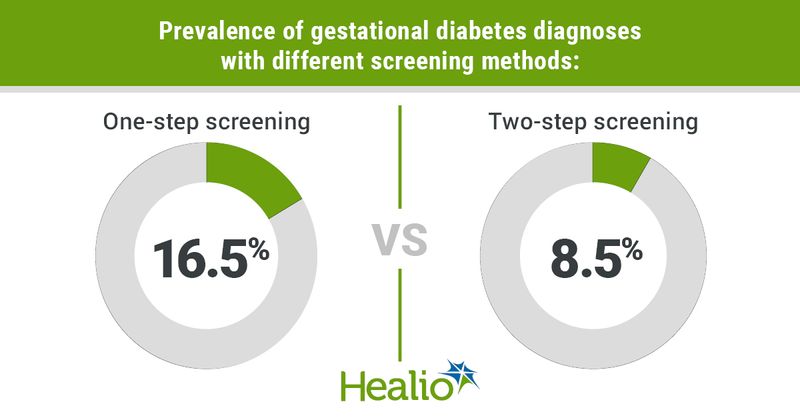One-step gestational diabetes screening identifies more cases
A one-step screening strategy for gestational diabetes resulted in nearly twice the diagnoses as a two-step strategy, according to research published in the New England Journal of Medicine.
However, researchers said there were no significant differences in complications among mothers or infants with the one-step vs. two-step strategy.

“Universal gestational diabetes screening is recommended at 24 to 28 weeks of gestation, since data from randomized, controlled trials show that treatment of gestational diabetes improves maternal and perinatal outcomes,” Teresa A. Hillier, MD, Center for Health Research Distinguished Investigator at Kaiser Permanente Northwest, and colleagues wrote. “There is no scientific consensus on how best to diagnose gestational diabetes.”
Hillier and colleagues compared outcomes in women who received gestational diabetes screening using the International Association of Diabetes and Pregnancy Study Groups’ one-step approach, and the American College of Obstetricians and Gynecologists’ two-step approach.
In the one-step approach, patients undergo a 2-hour oral glucose-tolerance test and are required to fast before the visit. For the two-step screening strategy, patients undergo a 1-hour glucose challenge test, and those with high glucose blood levels go back and undergo a 3-hour fasting diagnostic oral glucose-tolerance test.
Hillier and colleagues assessed outcomes in all pregnant women who presented for care from May 28, 2014, at Kaiser Permanente Northwest in Oregon and June 3, 2014, at Kaiser Permanente Hawaii through December 2017. Participants were randomly assigned to receive either one-step or two-step screening for gestational diabetes.
The researchers assessed 23,792 pregnant women, with 66% of women receiving one-step screening and 92% receiving two-step screening.
Hillier and colleagues found that 16.5% of women in the one-step group and 8.5% of those in the two-step group were diagnosed with gestational diabetes (unadjusted relative risk [RR] = 1.94; 97.5% CI, 1.79-2.11).
In their intention-to-treat analyses, the researchers determined that the incidence for infants who were large for gestational age was 8.9% in the one-step group and 9.2% in the two-step group (RR = 0.95; 97.5% CI, 0.87-1.05); the incidence for perinatal composite outcomes was 3.1% in the one-step group and 3% in the two-step group (RR = 1.04; 97.5% CI, 0.88 to 1.23).
They also found that the incidence of gestational hypertension or preeclampsia was 13.6% in the one-step group and 13.5% in the two-step group (RR = 1; 97.5% CI, 0.93-1.08), and the incidence of primary cesarean section was 24% in the one-step group and 24.6% in the two-step group (RR = 0.98; 97.5% CI, 0.93-1.02).
According to the researchers, the results were similar in analyses that accounted for differences in adherence between the one-step and two-step groups.
“In our large, randomized trial, one-step screening, as compared with two-step screening, doubled the incidence of the diagnosis of gestational diabetes but did not affect the risks of large-for-gestational-age infants, adverse perinatal outcomes, primary cesarean section, or gestational hypertension or preeclampsia,” Hillier and colleagues wrote.

